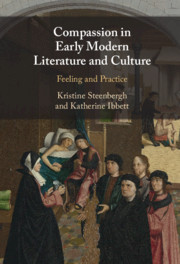Book contents
- Compassion in Early Modern Literature and Culture
- Compassion in Early Modern Literature and Culture
- Copyright page
- Contents
- Acknowledgements
- Contributors
- Introduction
- Part I Theorising
- Part II Consoling
- Part III Exhorting
- Chapter 5 ‘Compassion and Mercie Draw Teares from the Godlyfull Often’
- Chapter 6 Mollified Hearts and Enlarged Bowels
- Part IV Performing
- Part V Responding
- Part VI Giving
- Part VII Racialising
- Part VIII Contemporary Compassions
- Index
Chapter 5 - ‘Compassion and Mercie Draw Teares from the Godlyfull Often’
The Rhetoric of Sympathy in the Early Modern Sermon
from Part III - Exhorting
Published online by Cambridge University Press: 23 April 2021
- Compassion in Early Modern Literature and Culture
- Compassion in Early Modern Literature and Culture
- Copyright page
- Contents
- Acknowledgements
- Contributors
- Introduction
- Part I Theorising
- Part II Consoling
- Part III Exhorting
- Chapter 5 ‘Compassion and Mercie Draw Teares from the Godlyfull Often’
- Chapter 6 Mollified Hearts and Enlarged Bowels
- Part IV Performing
- Part V Responding
- Part VI Giving
- Part VII Racialising
- Part VIII Contemporary Compassions
- Index
Summary
This chapter examines the role played by sermons in developing the meaning of the term sympathy in the late sixteenth and early seventeenth centuries. When sympathy first appeared in English in the mid-sixteenth century it tended to be used in its physiological sense to refer to a correspondence or harmony between people, parts of the body, objects in the cosmos or the soul and the body. In the 1580s, however, preachers began to use sympathy in a narrower sense to refer to a mutual suffering between individual selves. Drawing upon works by Edwin Sandys, William James and Henry Holland, Meek argues that sermons from this period reflect and facilitate a shift in the understanding of sympathy from the physiological to the emotional and metaphorical – and that this process existed alongside similar developments taking place in dramatic culture. Meek argues that meditations on biblical narratives and exemplars may have played a more important role in shaping the understanding of compassion in the period than humoral or medical models.
- Type
- Chapter
- Information
- Compassion in Early Modern Literature and CultureFeeling and Practice, pp. 103 - 120Publisher: Cambridge University PressPrint publication year: 2021



